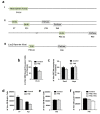Fetal alcohol exposure leads to abnormal olfactory bulb development and impaired odor discrimination in adult mice
- PMID: 21736737
- PMCID: PMC3148973
- DOI: 10.1186/1756-6606-4-29
Fetal alcohol exposure leads to abnormal olfactory bulb development and impaired odor discrimination in adult mice
Abstract
Background: Children whose mothers consumed alcohol during pregnancy exhibit widespread brain abnormalities and a complex array of behavioral disturbances. Here, we used a mouse model of fetal alcohol exposure to investigate relationships between brain abnormalities and specific behavioral alterations during adulthood.
Results: Mice drank a 10% ethanol solution throughout pregnancy. When fetal alcohol-exposed offspring reached adulthood, we used high resolution MRI to conduct a brain-wide screen for structural changes and found that the largest reduction in volume occurred in the olfactory bulbs. Next, we tested adult mice in an associative olfactory task and found that fetal alcohol exposure impaired discrimination between similar odors but left odor memory intact. Finally, we investigated olfactory bulb neurogenesis as a potential mechanism by performing an in vitro neurosphere assay, in vivo labeling of new cells using BrdU, and in vivo labeling of new cells using a transgenic reporter system. We found that fetal alcohol exposure decreased the number of neural precursor cells in the subependymal zone and the number of new cells in the olfactory bulbs during the first few postnatal weeks.
Conclusions: Using a combination of techniques, including structural brain imaging, in vitro and in vivo cell detection methods, and behavioral testing, we found that fetal alcohol exposure results in smaller olfactory bulbs and impairments in odor discrimination that persist into adulthood. Furthermore, we found that these abnormalities in olfactory bulb structure and function may arise from deficits in the generation of new olfactory bulb neurons during early postnatal development.
Figures





References
-
- Sampson PD, Streissguth AP, Bookstein FL, Little RE, Clarren SK, Dehaene P, Hanson JW, Graham JM. Incidence of fetal alcohol syndrome and prevalence of alcohol-related neurodevelopmental disorder. Teratology. 1997;56:317–326. doi: 10.1002/(SICI)1096-9926(199711)56:5<317::AID-TERA5>3.0.CO;2-U. - DOI - PubMed
Publication types
MeSH terms
Substances
Grants and funding
LinkOut - more resources
Full Text Sources

